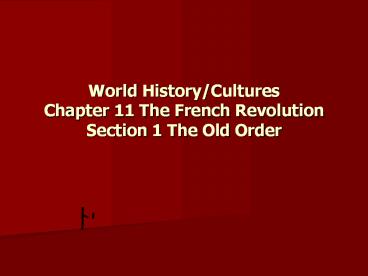World History/Cultures Chapter 11 The French Revolution Section 1 The Old Order - PowerPoint PPT Presentation
1 / 15
Title:
World History/Cultures Chapter 11 The French Revolution Section 1 The Old Order
Description:
World History/Cultures Chapter 11 The French Revolution Section 1 The Old Order Terms/Name Estate: One of three social classes in France during the 1700s. – PowerPoint PPT presentation
Number of Views:167
Avg rating:3.0/5.0
Title: World History/Cultures Chapter 11 The French Revolution Section 1 The Old Order
1
World History/CulturesChapter 11 The French
Revolution Section 1 The Old Order
2
- Terms/Name
- Estate One of three social classes in France
during the 1700s. First Estate- Roman Catholic
clergy Second Estate- Nobility Third Estate-
Commoners. Orders of society determined a
persons legal rights/status. - Tithe 10 tax on income from each church member
paid to the clergy. - Bourgeoisie Middle class between aristocrats
workers. The Third Estate.
3
- Terms/Name cont
- King Louis XVI 19 year old grandson of Louis
XV. Upon grandfathers death, became king in
1774. Wife- Marie Antoinette. Government
Cost-cutting measures. Began taxing nobility
clergy. Both groups refused to be taxed. King
summoned Estates-General to Versailles in May
1789. Hoped to gain agreement for tax. - Monarchy controlled France, a rich powerful
country. Only a few wealthy. Majority- poor, had
few rights wanted a better life. American
Revolution sparked their wanting change.
4
King Louis XVI
Marie Antoinette
5
- Divisions of French Society
- People were grouped into one of three estates,
orders of society. Third Estate members resented
First Second Estates.
6
- First Estate
- Clergy, 1 of population. Higher lower clergy.
- Did not pay taxes.
- Higher clergy controlled 5-10 of land. Grand
lifestyles supported by tithes. - Lower clergy- poor backgrounds ran schools
parishes.
7
- Second Estate
- Nobility 2 of population owned 25 of land.
- Grand lifestyles.
- High posts in government military.
- Main income from feudal dues from peasants who
lived worked on their land.
8
- Third Estate
- 97 of population peasants, artisans members
of bourgeoisie (middle class). - Few political rights/privileges.
- Read Enlightment works- freedom/social justice.
- Peasants owned 40 of land. Poor- had to pay
tithes, feudal dues, fines land tax.
9
- Growing Unrest
- Third Estate demanded change due to high cost of
living desire for more political power. - Second Estate- nobility wanted more political
influence resented monarchy. - Government financial problems- debts from wars
extravagant lifestyle of Louis XV. - 1774- King Louis XVI in power deals with
financial crisis. Taxed nobility clergy-
refused to pay taxes. - 1786- Banks refused to lend money to government.
Crop failures in 1788-89 caused bread shortages. - King Louis XVI called for Estates-General to meet.
10
- Meeting of Estates-General
- King Louis XVI hoped First Second Estates would
agree to be taxed. - Second Estate wanted to protect privileges gain
control of government. First Estate wanted to
control Third Estate. - Third Estate refused plan of First Second
Estate. Called for joint meeting with each estate
voting individually. - King demanded estates meet separately. Third
Estate refused and locked out of Estates-General.
11
- Meeting of Estates-General cont
- Third Estate renamed the National Assembly and
met at an indoor tennis court with deputies from
First Second Estates who supported them. - National Assembly took the Tennis Court Oath.
Promised not to disband until they wrote a
constitution for France. - King ordered First Second Estates to join Third
Estates National Assembly.
12
- Revolt
- National Assembly delegates expressed dismay with
rigid French social order government. Third
Estate wanted social equality. Rebellion ideas
spread. - King gathered more troops at palace in
Versailles. - Fearing king wanted to dissolve National Assembly
stop reforms, focused on Bastille, the French
prison.
13
Bastille
14
- Events Lead to Revolution
- Bastille represented injustices of monarchy.
- July 14, 1789 Mob surrounded Bastille to steal
weapons defend National Assembly. - Mob freed 7 prisoners. 98 rioters killed. Prison
commander several soldiers killed. - Outbreak led to formation of revolutionary
government in Paris. - Bastilles storming led to the Great Fear-
violence. Hearing rumors, peasants feared losing
land armed themselves. - Peasants anxiety grew turned to violence.
Drove landlords off property refused to pay
feudal dues. Broke into manors robbed
granaries. First wave of French Revolution.
15
The Great Fear

